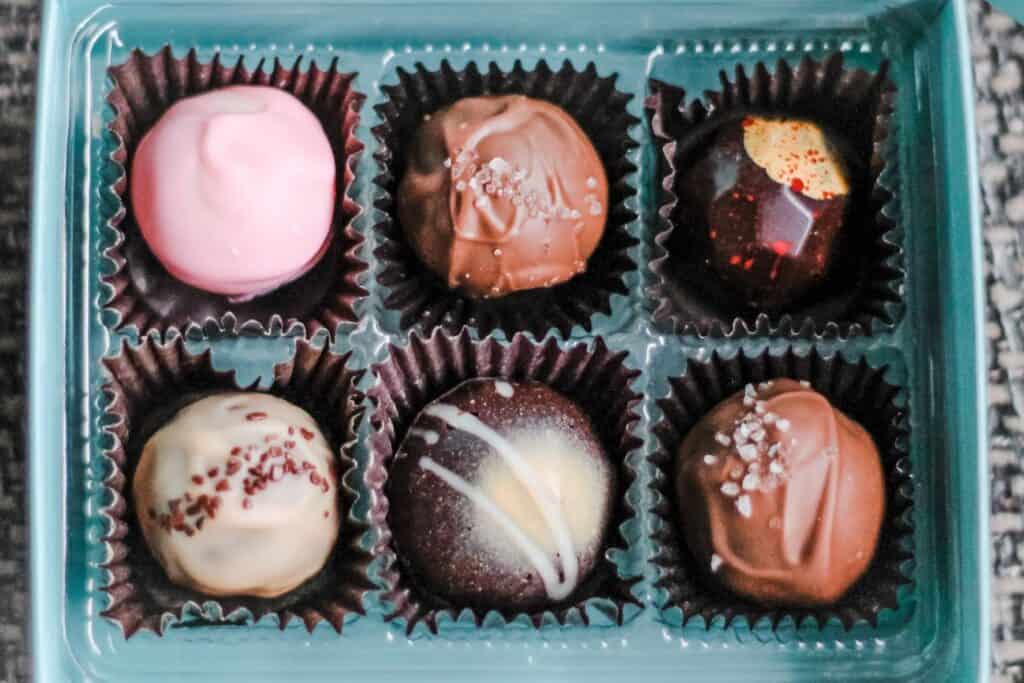I don’t know about you, but I’m always looking to cut down on the little plastic things that enter my house as well as anything that we just don’t really need. This post explores consumable and sustainable stocking stuffer for kids and teens.

Consumable and sustainable stocking stuffers are the way to go, because they are either items that get used fairly quickly (you would buy them anyways) or they are quality items that are consciously made and will likely last for a long time. Consumable and sustainable items aren’t likely to end up in the junk drawer or at the bottom of the toy box.
I didn’t truly know what junk was until I had kids! Wow, the stuff they accumulate between school, birthday parties and just everyday life is unreal. I’m fairly sure this has increased greatly over the years, because I don’t recall having even a fraction of the little trinkets and disposable-type toys that are around today.
If you are looking for ways to cut down on all the little things, I believe the holidays offer up some great opportunities to do just that. From Easter baskets to birthday goodie bags to Christmas stockings, there are lots of places we can reduce our plastic consumption and waste in general.
The trouble with traditional stocking stuffers?
Traditional stocking stuffers are often made as cheaply from plastic or other undesirable materials. They don’t last very long and at my house they end up in the junk drawer really quick. Most popular stocking stuffers are made in China or other countries with low safety standards in regard to air pollution, worker safety and materials used.
Think the $1 section at Target, the holiday aisle at most grocery stores or the ever-popular Oriental Trading.
Once these items are tossed to the side, they make their way to the landfills, and some make its way into our lakes, streams and oceans. Each year, 11 million metric tons of plastic enter our oceans on top of the estimated existing 200 million metric tons that are already there.

During the 2017 International Costal Cleanup the ten most common items found were food wrappers, beverage bottles, grocery bags, straws and take out containers, which are all made of plastic. While plastic doesn’t decompose, it does break down into microplastics, which cause harm to our marine ecosystems.
The plastics harm animals physically by trapping them or by ingestion. Here’s a great article to learn more about the danger posed by plastics to our marine ecosystem.
Other common sources of microplastics are home goods like blankets, curtains and sheets as well as clothing or accessories, which are often made from polyester, nylon and Lycra. We don’t always think of these things when we think of plastic pollution.
How can I reduce my plastic use?
When you think about all of those sources at once, reducing plastic can feel overwhelming. Some simple ways to start making changes are switching to reusable straws, drinking from a stainless-steel water bottle, carrying cloth grocery and shopping bags and buying more cotton/natural materials.
If you think about one year’s worth of straws, plastic bottles, grocery bags and synthetic clothing/home goods for just one person, you’ll realize what an impact you can have. I suspect those items alone could fill up a small bathroom. It’s pretty cool to think about single-handedly reducing ocean pollution by the size of a bathroom each year!
Now, let’s get back to why you are here … to look at some consumable and sustainable stocking stuffers.
What makes an item consumable?
A consumable item is pretty simple, just like it sounds. It is something that is consumed rather than something that is meant to be kept or last for years. There are the obvious consumables like food and drink items then there are the less obvious ones like deodorant, socks or, say, ink paints.
The second group are consumed a little more slowly, but since they are replaced fairly often, they are considered consumable.

This post contains affiliate links. I may earn a small commission on qualifying purchases.
What makes an item sustainable?
We see everything now from sustainable farming practices to wood products made from sustainable forestry. Sustainable means that the practices will not harm the environment in devastating ways for future generations. It means there is a sort of a give and take with mother nature. For example, the trees are replanted, the sheep’s wool grows back, etc.
Consumable items are not always sustainable and sustainable items are not always consumable, but most of the items traditionally marketed as stocking stuffers are not consumable or sustainable. A good goal to reduce waste this holiday season, is to look for products that fall into at least one of these categories. Some items could fit into both categories, which is fantastic.
Consumable Stocking Stuffer Ideas
Most of these items would have been purchased anyways, so you aren’t necessarily buying more. I have linked to some of my personal favorites—several of which found their way into my kids’ stockings this year.
- Favorite Snacks
- Chocolate/Candy (like these naturally dyed candy canes). Check Aldi, Whole Foods & Trader Joe’s!
- Gum
- Homemade Hot Cocoa Bombs
- Play-Doh
- Small Sports Gear (batting gloves, golf balls, etc.)
- Chapstick/Lip Gloss
- Socks or Underwear
- Deodorant
- Festive Body Butter or Lotion
- Body or Pillow Spray
- Bath Bombs
- Makeup Palette
- Hair Acessories
- Earbuds
- Fun Toothpaste
- Toothbrush
- Holiday Candles
- Ink pens/Pencils/Markers
- Journal or Planner
- Small Paint Set (finger paints for little ones)
- Nail Polish (Piggy Paint for little ones)
- An Experience (theater, sports or zoo tickets/pass)
- Handmade Coupon Book (these are so cute!)
- Gift Cards or an E-Gift Card

Sustainable Stocking Stuffer Ideas
- Handmade Wooden Ornament or Clay (DIY)
- Natural Fabric Scarf, Toboggan or Gloves
- Natural Fabric Socks (these wool socks come with a lifetime guarantee)
- Classic or Secondhand Books
- Reusable Snack Bags
- Thermos
- Handmade or Eco-Friendly Stuffed Animal
- Sustainable Silver Jewelry
- Eco-friendly Wallet or ID Holder
- Engraved Money Clip
- Makeup/Toiletries Bag
- Glass or Stainless-Steel Water Bottle
- Small Framed Picture (2nd hand or handmade frame)
- Stainless-Steel or Glass Mug or Cup
- Stainless-Steel or Silicone Straws
- Recycled Phone or Tablet Case
- Quality Manicure Set (clippers, file, etc.)
- Small Green Toys
- Legos (still plastic, BUT safer, recyclable, and they last forever!)
- Quality or Passed Down Pocket Knife
- Stainless Steel Compact
- Bicycle Playing Cards
- Stainless Steel or Wooden Ring/Jewelry Box
- Canvas Coin Purse
- Baby Cactus (probably safer on the mantle than in the stocking)
- Handwritten Letter or Card (using what you have on hand)
Obviously, the brand and other variables will play a role in how sustainable the items on this list are. Brands that go out of their way to use sustainable materials, practices or both tend to be easy to spot as they aren’t shy about sharing the information (can’t blame them!).
Many sustainable items can get quite expensive, so I tried to provide a mix of free, low-cost and investment-type items.
One way to offset additional cost is to buy less or even buy second hand. If you are on a budget, maybe choose one pricier item for the stocking and surround it with snacks, a coupon book and a letter.
These are not all perfect items, but they are better options than the disposable plastic toys and trinkets that are often used to fill stockings. I hope you spotted a few things that you may want to use to stuff a stocking. If you are looking to reduce waste this holiday season, check out my related post: 3 Eco-Friendly Gift Wrapping Ideas.